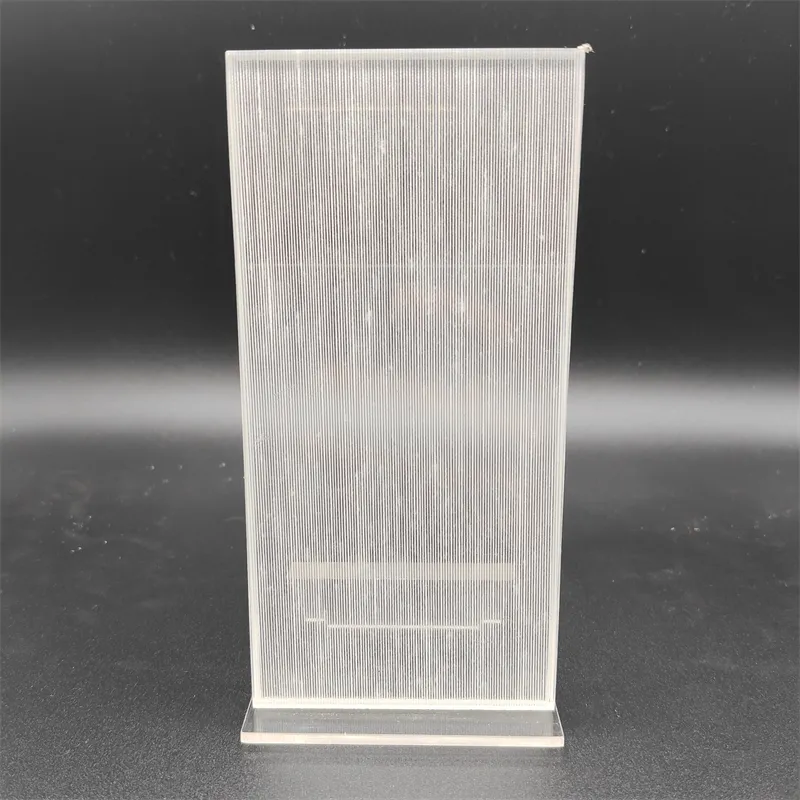Nov . 20, 2024 06:57 Back to list
curved safety glass
Curved Safety Glass A Comprehensive Overview
In the realm of modern architecture and design, safety is paramount. Among the various safety materials employed in construction, curved safety glass has emerged as a critical component, offering both aesthetic appeal and enhanced protection. This article delves into the characteristics, manufacturing processes, applications, and advantages of curved safety glass, illustrating why it is becoming an indispensable choice in contemporary design.
Understanding Curved Safety Glass
Curved safety glass is a type of glass that has been specifically designed, treated, or fabricated to have a curved shape while meeting safety standards. It is often made from tempered or laminated glass to enhance its strength and resilience. Tempered glass is heated and then rapidly cooled, resulting in a product that is much stronger than standard glass. If broken, it shatters into small, blunt pieces, reducing the risk of injury. Laminated glass consists of two or more layers of glass with an interlayer of polyvinyl butyral (PVB) or similar materials, providing additional structural integrity and safety.
Manufacturing Process
The fabrication of curved safety glass involves several intricate steps. Initially, flat glass sheets are heated to a pliable state in a furnace. Once the glass reaches the appropriate temperature, it is shaped by placing it over a mold. The glass is then cooled gradually to maintain its final shape. This process can be complemented by tempering, which involves re-heating and cooling to enhance its strength. For laminated glass, the interlayer is inserted between curved glass layers, and then the assembly is placed in an autoclave where heat and pressure ensure a strong bond.
Applications
Curved safety glass is frequently utilized in various applications across multiple industries
. In architectural design, it is commonly used in facades, skylights, and windows, allowing for innovative and organic shapes that enhance aesthetic appeal while ensuring safety. Residential buildings, commercial spaces, and public structures all benefit from the versatility of curved safety glass.In the automotive industry, curved safety glass is essential for windshields and side windows. The curvature of the glass not only contributes to the vehicle's sleek design but also significantly improves aerodynamics. Additionally, it enhances passenger safety by providing superior visibility and minimizing the risk of severe injuries in the event of an accident.
curved safety glass

Moreover, the use of curved safety glass extends into the realm of interior design. It is often employed in the crafting of partitions, balustrades, and shower enclosures, providing an elegant and modern look while ensuring user safety.
Advantages of Curved Safety Glass
1. Aesthetic Flexibility Curved safety glass allows architects and designers to push creative boundaries. The ability to craft flowing lines and unique shapes provides numerous design possibilities, making structures visually appealing and innovative.
2. Enhanced Strength The manufacturing processes involved in making curved safety glass result in products that are significantly more resistant to impact and stress compared to standard glass. This resilience makes it ideal for high-traffic areas and structures subject to environmental forces.
3. Improved Safety The inherent properties of tempered and laminated glass minimize the risk of serious injuries from glass fractures. The way tempered glass shatters and the layering effect of laminated glass contribute to a safer environment.
4. Energy Efficiency Curved safety glass can be designed to incorporate energy-efficient coatings that help regulate temperature and reduce heating or cooling costs. This feature is particularly advantageous in green building designs aimed at sustainability.
5. Ease of Maintenance Advanced coatings can be applied to curved safety glass, making it easier to clean and maintain, ensuring that the surfaces stay clear and visually appealing over the long term.
Conclusion
Curved safety glass is more than just an aesthetic choice; it represents a significant advancement in safety and design. As architects and designers continue to explore new forms and structures, curved safety glass will play a crucial role in shaping the built environment. By combining beauty, strength, and safety, this innovative material not only satisfies regulatory standards but also enhances the quality of life in urban settings. As technology and manufacturing processes continue to evolve, curved safety glass is poised to become an even more prominent feature in both residential and commercial projects, ensuring that safety does not come at the expense of creativity and design.
-
Safety and Style with Premium Laminated Glass Solutions
NewsJun.24,2025
-
Reinvents Security with Premium Wired Glass
NewsJun.24,2025
-
Premium Float Glass Line for Modern Architecture
NewsJun.24,2025
-
Low Emissivity Glass for Energy-Efficient Architecture
NewsJun.24,2025
-
High-Performance Insulated Glass Solutions for Modern Architecture
NewsJun.24,2025
-
Elevates Interior Style with Premium Silver Mirror
NewsJun.24,2025
Related PRODUCTS














